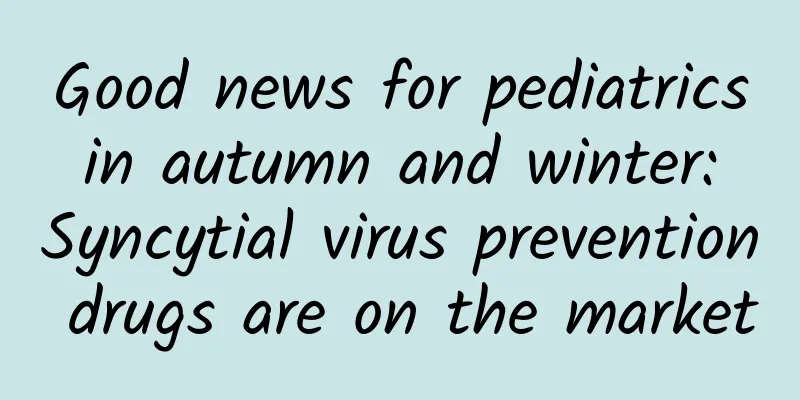Good news for pediatrics in autumn and winter: Syncytial virus prevention drugs are on the market

|
This is the 5168th article of Da Yi Xiao Hu Autumn and winter are the peak seasons for respiratory infectious diseases, including influenza, epidemic meningitis, mumps, hand, foot and mouth disease, and new coronavirus infection. In recent years, the incidence of mycoplasma, respiratory syncytial virus, and adenovirus among adolescents and children is relatively high. In particular, respiratory syncytial virus will enter the epidemic period from October every year. Syncytial virus is a common and highly contagious respiratory virus. It is the primary pathogen detected in infants under 1 year old who are hospitalized for lung infection. Infants with severe syncytial virus infection may have impaired lung function such as repeated wheezing or asthma, which will have long-term effects on children. Syncytial virus is an RNA virus that is transmitted through droplets and close contact, or through contaminated hands and surfaces. Patients often experience upper respiratory tract symptoms after infection. The incubation period of syncytial virus is usually 2 to 8 days, and excretion of toxins from the body can last for 1 to 3 weeks. Most early infections are confined to the upper respiratory tract, manifested by upper respiratory tract symptoms such as nasal congestion, runny nose, cough and hoarseness. The typical symptoms of adults after infection are very similar to the common cold, such as low fever, cough, nasal congestion, and runny nose. Most patients' symptoms will disappear on their own within 1 to 2 weeks. Moderate and severe cases have more obvious dyspnea, wheezing, cyanosis of the lips and mouth, nasal fan and three-depression signs, and a few severe cases may also be complicated by heart failure. Since maternal antibodies cannot completely prevent infection, syncytial virus pneumonia can occur at any time after birth. It is more common in children under 3 years old, and more severe cases can be seen in 1 to 6 months. It is more common in winter and spring in northern my country, and more common in spring and summer in Guangdong. Since antibodies cannot completely prevent infection, reinfection with syncytial virus is extremely common. Some people have observed that the incidence of reinfection is as high as 65% in 10 years. Syncytial virus is highly contagious. There are reports of family members being infected one after another. When it occurs within the family, older children and adults generally have upper respiratory tract infections. Syncytial virus may cause severe coughing and persistent wheezing in young children. In severe cases, there is a risk of respiratory failure. It is also a relatively dangerous virus for children. Since the autumn of 2004, it has been marketed in Europe and the United States. Literature has reported that this innovative prevention method can effectively reduce the risk of hospitalization of infants due to lower respiratory tract infections caused by syncytial virus by 82%. The efficacy is very high. my country's first vaccine to prevent lower respiratory tract infections caused by syncytial virus, the long-acting monoclonal antibody Nissvir monoclonal antibody injection (Leweichu), only needs a single injection to provide timely, rapid and direct protection for newborns and infants who are about to enter or are born in the first respiratory syncytial virus infection season, thereby preventing lower respiratory tract infections caused by syncytial virus. For newborns or infants under 1 year old who are about to enter or are born in the first syncytial virus infection season: the recommended dose for infants weighing less than 5kg is a single intramuscular injection of 50mg; the recommended dose for infants weighing greater than or equal to 5kg is a single intramuscular injection of 100mg. Starting from September 26, 2024, the public can search for the RSV prevention appointment applet through WeChat "Search" to learn about the detailed appointment map. Some hospitals have begun to carry out vaccination work in accordance with "informed consent, voluntary self-payment, local management, and orderly advancement". The first batch of pilot users in Shanghai are 7 vaccination clinics set up in municipal obstetric specialist medical institutions and municipal children's specialist medical institutions. The other 4 are Shanghai Children's Hospital, Xinhua Hospital Affiliated to Shanghai Jiaotong University School of Medicine, China Welfare Institute International Peace Maternity and Child Health Hospital, and Shanghai First Maternity and Infant Health Hospital. Author: Putuo District Central Hospital Department of Respiratory Medicine Shi Zhaowen, deputy chief physician |
Recommend
What to do if your menstrual flow is light after miscarriage
Because of various reasons, many people have to c...
Why do women have dampness? What are the symptoms of heavy dampness?
As the weather gets hotter, many people will beco...
What is the normal amount of progesterone?
Some women have not gotten pregnant after prepari...
What is the function of hair? You must know this knowledge!
Everyone has hair, and the amount of hair is main...
Why do I retch but not vomit during pregnancy?
Most women experience varying degrees of pregnanc...
What is the difference between iodine and iodine tincture? Which is better?
Iodine tincture has good disinfection effect. It ...
How to recover after a cesarean section
Due to various factors, many pregnant women choos...
How many days after menstruation does ovulation begin?
Recently, many female friends have been asking ho...
Is colposcopy a surgery?
Colposcopy is certainly not a surgical procedure....
Can I practice yoga during my menstrual period?
I believe that there are always a few days every ...
How long does it take to do a blood test for pregnancy?
When women want to know whether they are pregnant...
What should I do if the rolled dough becomes hard overnight? Will eating rolled dough make me fat?
Rolled noodles evolved from cold noodles in the T...
Although cupping can detoxify and maintain health, these matters should be paid attention to
Nowadays, people pay attention to health preserva...
What are the causes of hip pain and backache in women?
Many women in contemporary society feel pain in t...









